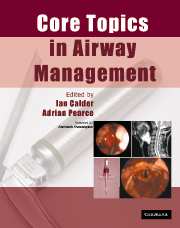Book contents
- Frontmatter
- Contents
- List of contributors
- Preface
- Acknowledgements
- List of abbreviations
- 1 Anatomy
- 2 Physiology of apnoea and hypoxia
- 3 Physics and physiology
- 4 Cleaning and disinfection of airway equipment
- 5 General principles
- 6 Maintenance of the airway during anaesthesia: supra-glottic devices
- 7 Tracheal tubes
- 8 Tracheal intubation of the adult patient
- 9 Confirmation of tracheal intubation
- 10 Extubation
- 11 Light-guided intubation: the trachlight
- 12 Fibreoptic intubation
- 13 Retrograde intubation
- 14 Endobronchial and double-lumen tubes, bronchial blockers
- 15 ‘Difficult airways’: causation and prediction
- 16 The paediatric airway
- 17 Obstructive sleep apnoea and anaesthesia
- 18 The airway in cervical trauma
- 19 The airway in cervical spine disease and surgery
- 20 The aspiration problem
- 21 The lost airway
- 22 Trauma to the airway
- 23 Airway mortality associated with anaesthesia and medico-legal aspects
- 24 ENT and maxillofacial surgery
- 25 Airway management in the ICU
- 26 The airway in obstetrics
- Index
3 - Physics and physiology
Published online by Cambridge University Press: 15 December 2009
- Frontmatter
- Contents
- List of contributors
- Preface
- Acknowledgements
- List of abbreviations
- 1 Anatomy
- 2 Physiology of apnoea and hypoxia
- 3 Physics and physiology
- 4 Cleaning and disinfection of airway equipment
- 5 General principles
- 6 Maintenance of the airway during anaesthesia: supra-glottic devices
- 7 Tracheal tubes
- 8 Tracheal intubation of the adult patient
- 9 Confirmation of tracheal intubation
- 10 Extubation
- 11 Light-guided intubation: the trachlight
- 12 Fibreoptic intubation
- 13 Retrograde intubation
- 14 Endobronchial and double-lumen tubes, bronchial blockers
- 15 ‘Difficult airways’: causation and prediction
- 16 The paediatric airway
- 17 Obstructive sleep apnoea and anaesthesia
- 18 The airway in cervical trauma
- 19 The airway in cervical spine disease and surgery
- 20 The aspiration problem
- 21 The lost airway
- 22 Trauma to the airway
- 23 Airway mortality associated with anaesthesia and medico-legal aspects
- 24 ENT and maxillofacial surgery
- 25 Airway management in the ICU
- 26 The airway in obstetrics
- Index
Summary
Physics of airflow
Gas flowing through tubes can be characterized by possessing either laminar or turbulent flow, or more usually, a mixture of both. Before we explore these, we need to familiarize ourselves with a fundamental thermodynamic concept detailed below.
Laminar flow
In laminar flow, although gas molecules in different parts of the ‘stream’ have different velocities, the vectors of these velocities are parallel, as shown in Figure 3.1.
For a viscous Newtonian fluid such as air, molecules can be thought of as being arranged in slippery ‘sheets’ or ‘layers’ and these have been schematically labelled 1, 2, 3, etc. in Figure 3.1. The sheet of molecules closest to the wall of the tube (sheet 1) is stationary and bound to the wall of the tube. Each sheet of molecules can exert a force on its neighbour (‘shear’ force) so that a slow moving sheet will tend to retard a quicker moving neighbour, and quicker moving sheets will tend to drag slower neighbours along. For example, the shear forces exerted on sheet 2 by the stationary sheet 1 would tend to retard it, but the shear force exerted by its other neighbour, the faster moving sheet 3, would tend to increase its velocity. The sheets of molecules in the middle of the stream (e.g. sheet 3) are the least influenced by the static layers at the edges, and so these have the highest velocity. The amount of grip which one sheet has on another (the shear force) is a property of the viscosity of the fluid. For low viscosity (i.e. slippery) fluids, the stationary boundary layer has little ‘grip’ on its neighbour and so the velocity of subsequent layers rises very quickly as one moves towards the centre of the stream.
- Type
- Chapter
- Information
- Core Topics in Airway Management , pp. 21 - 30Publisher: Cambridge University PressPrint publication year: 2005

